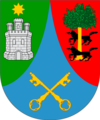Atxondo
| Atxondo | ||
|---|---|---|
| Municipality | ||

General overview of the valley of Atxondo
|
||
|
||
| Location of Atxondo within the Basque Country | ||
| Coordinates: 43°07′48″N 2°35′01″W / 43.13000°N 2.58361°W | ||
| Country |
|
|
| Autonomous community |
|
|
| Province | Biscay | |
| Comarca | Durangaldea | |
| Government | ||
| • Mayor | Rosa Maria Elizburu Oyanguren (Bildu) | |
| Area | ||
| • Total | 23,21 km2 (896 sq mi) | |
| Elevation | 170 m (560 ft) | |
| Population (2010) | ||
| • Total | 1.433 | |
| • Density | 0.00062/km2 (0.0016/sq mi) | |
| Demonym(s) | Atxondoarra | |
| Time zone | CET (UTC+1) | |
| • Summer (DST) | CEST (UTC+2) | |
| Postal code | 48291 | |
| Website | Official website | |
Atxondo (Spanish: Achondo) is a municipality located in the province of Biscay, in the Basque Country, Spain. Atxondo is part of the comarca of Durangaldea and has a population of 1.447 inhabitants as of 2007 according to the Spanish National Statistics Institute.
Atxondo was formed by the fusion of the former municipalities of the elizates of Apatamonasterio, Arrazola and Axpe in 1962.
The name Atxondo comes from the fusion of the Basque words (h)A(i)tz, which means "rock", and ondo, which means at the side of, then "at the side of the rock". Axpe means "under the rock".
Until 1962, Achondo was the name for a valley where three different municipalities formed by three elizates where located; Apatamonasterio, Arrazola and Axpe, each of them with history of its own.
The name Apatamonasterio means "clergy monastery" and was chosen to differentiate the monastery opened here to the one in the elizate of Etxebarria. It took part on the War of the Bands. As a member of the ancient merindad of Durango, it had voice and right to vote in the Juntas of Guerendiaga, where it occupied the seat number eight. Until 1857 it did not have a church of its own, depending on the one of Abadiño. Historically, its economy has depended on farming.
It also took part on the War of the Bands and had voice and right to vote in the Juntas of Guerendiaga, where it occupied the seat number eight. In Arrazola was born Esteban de Urizar, governor of Peru during the reign of Philip II and Juan Alexandro Arrazola de Oñate who was Chamberlain of Archduke Albert and Archduchess Isabella in the Spanish Netherlands. In 1510 the church was built with the approval of the Catholic Monarchs.
...
Wikipedia


